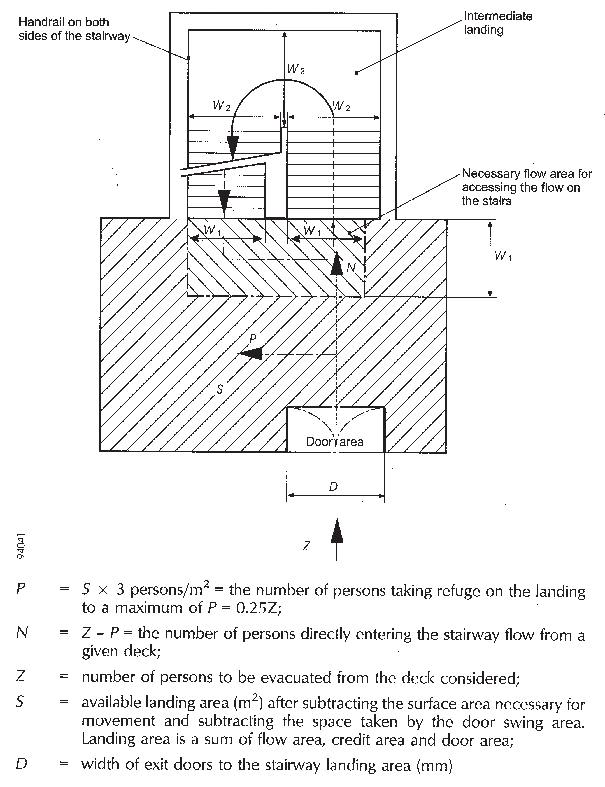2.1.2.1
Basic principles of the
calculation
2.1.2.1.1 This calculation method determines
the minimum stairway width at each deck level, taking into account
the consecutive stairways leading into the stairway under consideration.
2.1.2.1.2 It is the intention that the
calculation method shall consider evacuation from enclosed spaces
within each main vertical zone individually and take into account
all of the persons using the stairway enclosures in each zone, even
if they enter that stairway from another vertical zone.
2.1.2.1.3 For each main vertical zone
the calculation shall be completed for the night time (case 1) and
day time (case 2) and the largest dimension from either case used
for determining the stairway width for each deck under consideration.
2.1.2.1.4 The calculation of stairway
widths shall be based upon the crew and passenger load on each deck.
Occupant loads shall be rated by the designer for passenger and crew
accommodation spaces, service spaces, control spaces and machinery
spaces. For the purpose of the calculation the maximum capacity of
a public space shall be defined by either of the following two values:
the number of seats or similar arrangements, or the number obtained
by assigning 2 m2 of gross deck surface area to each person.
2.1.2.2
Calculation method for
minimum value
In considering the design of stairway widths for
each individual case which allow for the timely flow of persons evacuating
to the assembly stations from adjacent decks above and below, the
following calculation methods shall be used (see
figures 1 and 2):
| when
joining two decks:
|
W =
(N1 + N2) x 10 mm;
|
| when
joining three decks:
|
W =
(N1 + N2 + 0.5N3) x 10 mm;
|
| when
joining four decks:
|
W =
(N1 + N2 + 0.5N3 +
0.25N4) x 10 mm; and
|
| when joining five decks or more decks, the width
of the stairways shall be determined by applying the above formula for
four decks to the deck under consideration and to the consecutive
deck,
|
| where:
|
|
|
| W
|
=
|
the
required tread width between handrails of the stairway.
|
| The calculated value of W may be reduced where
available landing area S is provided in stairways at the deck level
defined by subtracting P from Z, such that:
|
| P
|
=
|
S x
3.0 persons/m2; and Pmax = 0.25Z
|
| where:
|
|
|
| Z
|
=
|
the
total number of persons expected to be evacuated on the deck being
considered
|
| P
|
=
|
the
number of persons taking temporary refuge on the stairway landing,
which may be subtracted from Z to a maximum value of P = 0.25Z (to be
rounded down to the nearest whole number)
|
| S
|
=
|
the
surface area (m 2 ) of the landing, minus the surface area
necessary for the opening of doors and minus the surface area
necessary for accessing the flow on stairs (see
figure 1)
|
| N
|
=
|
the
total number of persons expected to use the stairway from each
consecutive deck under consideration; N1 is for the deck with the
largest number of persons using that stairway; N2 is taken for the
deck with the next highest number of persons directly entering the
stairway flow such that, when sizing the stairway width as each deck
level, N1 > N2 > N3 > N4 (see
figure 2). These decks are assumed to be on or
upstream (i.e. away from the embarkation deck) of the deck being
considered.
|

Figure 1 Landing Calculation for Stairway Width Reduction
Figure 2 Minimum Stairway Width (W) Calculation Example
2.1.2.2.2
Distribution of persons
2.1.2.2.2.1 The dimension of the means
of escape shall be calculated on the basis of the total number of
persons expected to escape by the stairway and through doorways, corridors
and landings (see figure 3). Calculations
shall be made separately for the two cases of occupancy of the spaces
specified below. For each component part of the escape route, the
dimension taken shall not be less than the largest dimension determined
for each case:
| Case 1:
|
Passengers in cabins with
maximum berthing capacity fully occupied; members of the crew in
cabins occupied to 2/3 of maximum berthing capacity; and service
spaces occupied by 1/3 of the crew.
|
| Case 2:
|
Passengers in public spaces
occupied to 3/4 of maximum capacity, 1/3 of the crew distributed in
public spaces; service spaces occupied by 1/3 of the crew; and crew
accommodation occupied by 1/3 of the crew.
|
Figure 3 Occupant Loading Calculation
2.1.2.2.2.2 The maximum number of persons contained
in a vertical zone, including persons entering stairways from another
main vertical zone, shall not be assumed to be higher than the maximum
number of persons authorized to be carried on board for the calculation
of stairway widths only.